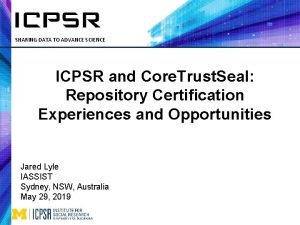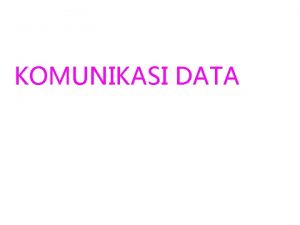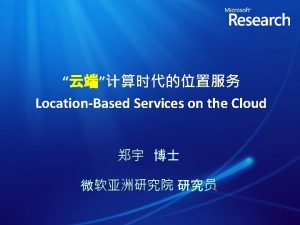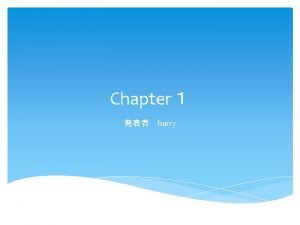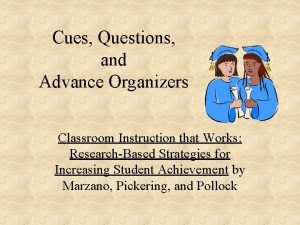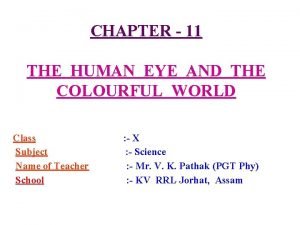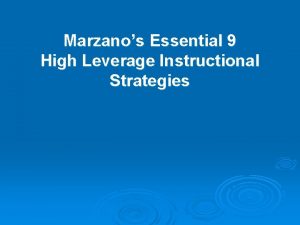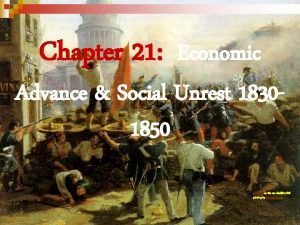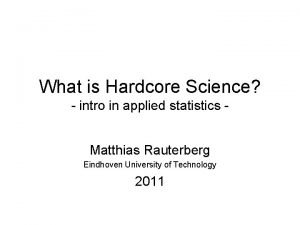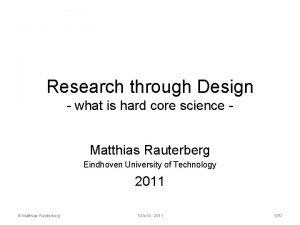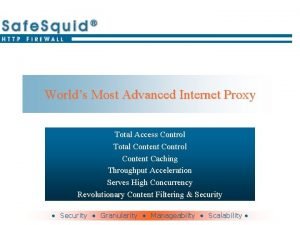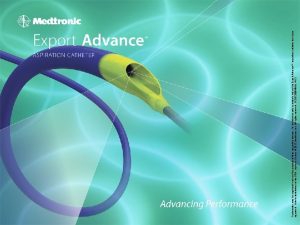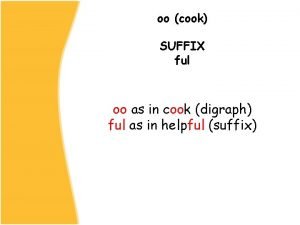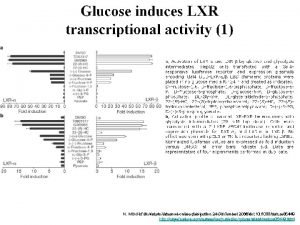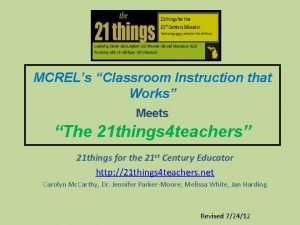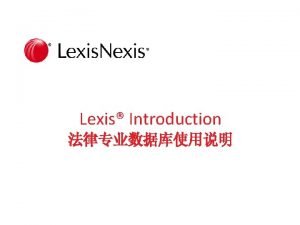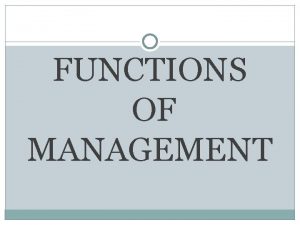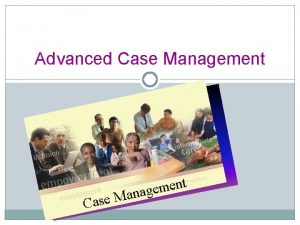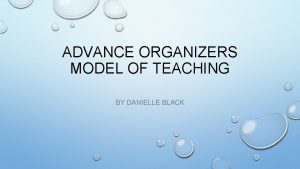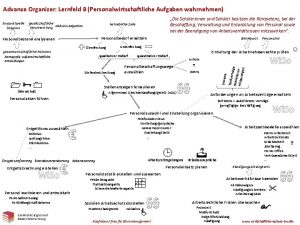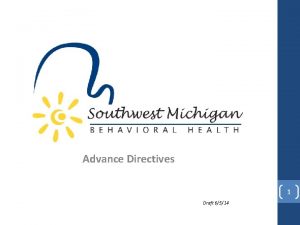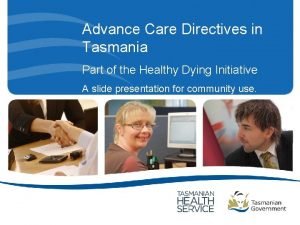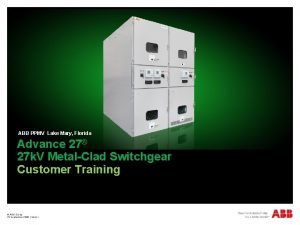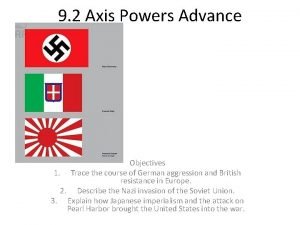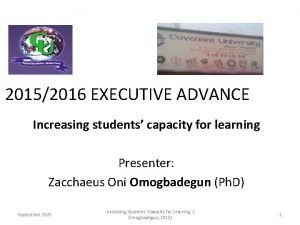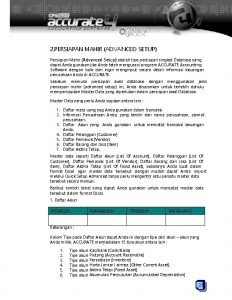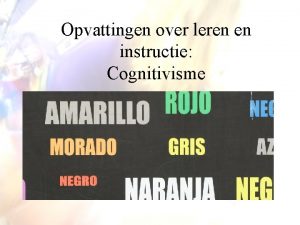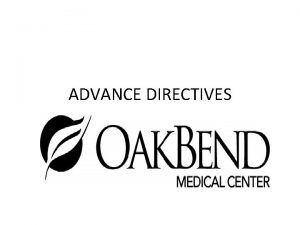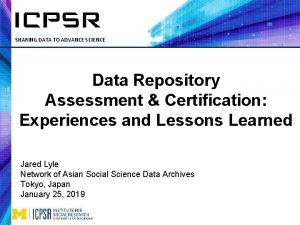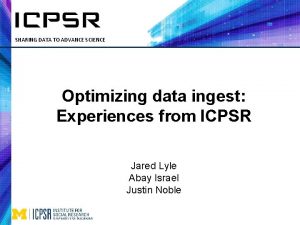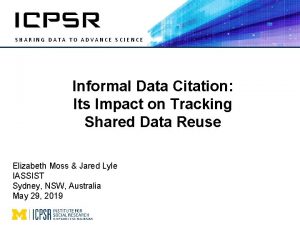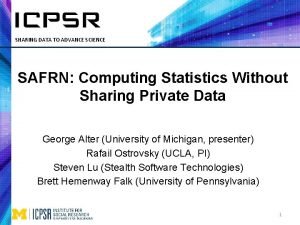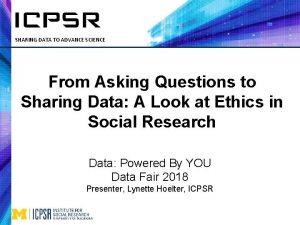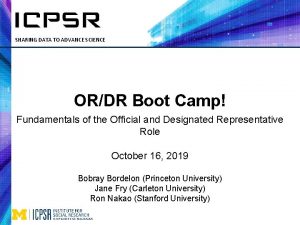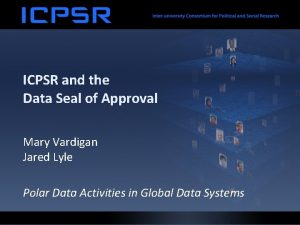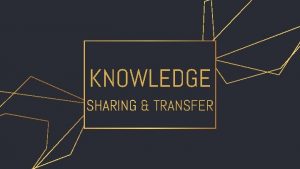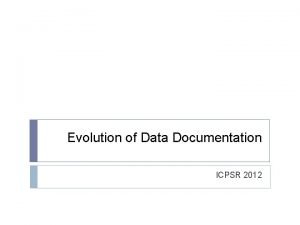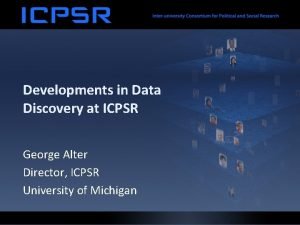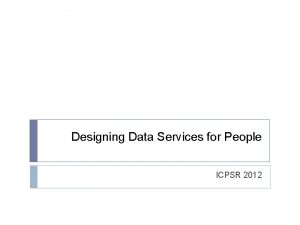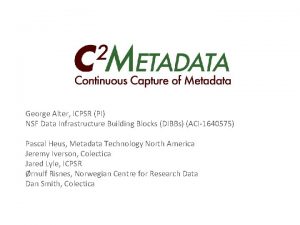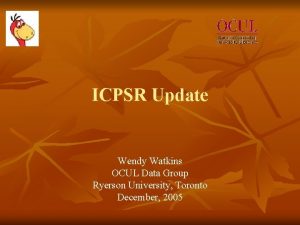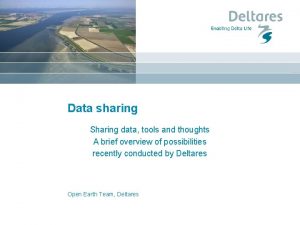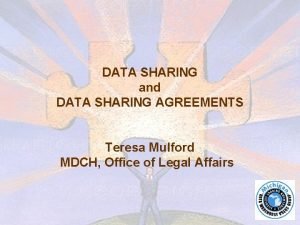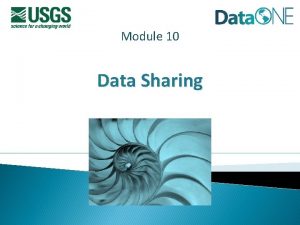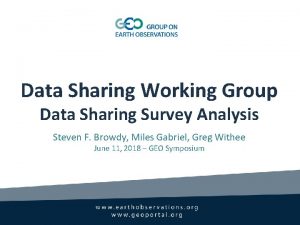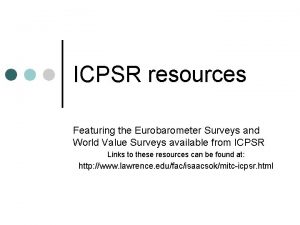SHARING DATA TO ADVANCE SCIENCE ICPSR and Core































![ICPSR Response: R 5 (references) References: [1] ICPSR Web site, About the Organization: https: ICPSR Response: R 5 (references) References: [1] ICPSR Web site, About the Organization: https:](https://slidetodoc.com/presentation_image_h/b6ce0c768f3c5e372eaf3d1c40231fa2/image-32.jpg)












- Slides: 44

SHARING DATA TO ADVANCE SCIENCE ICPSR and Core. Trust. Seal: Repository Certification Experiences and Opportunities Jared Lyle IASSIST Sydney, NSW, Australia May 29, 2019

Outline • Overview of ICPSR • Why assessment is important • ICPSR’s experience with assessment, including effort and resources needed • Benefits from assessment • Opportunities to improve the process

http: //www. icpsr. umich. edu

ICPSR • Established 1962 • Originally 22 Members, now consortium of 776 world-wide • Originally Political Science, now all social and behavioral sciences Philip Converse, Warren Miller, and Angus Campbell Source: http: //www. icpsr. umich. edu/icpsrweb/content/membership/history/timeline. html

ICPSR • Current holdings • 10, 000+ studies, quarter million files • 1500+ are restricted studies, almost always to protect confidentiality • Bibliography of Data-related Literature with 80, 000 citations • Approximately 60, 000 active My. Data (“shopping cart”) accounts • Thematic collections of data about addiction and HIV, aging, arts and culture, child care and early education, criminal justice, demography, health and medical care, and minorities

Why Assessment is Important

• Provide transparent view into the repository • Improve processes and procedures • Measure against a community standard • Show the benefits of domain repositories • Promote trust by funding agencies, data producers, and data users that data will be available for the long term Dillo, I. , & de Leeuw, L. (2018). Core. Trust. Seal. Communications of the Association of Austrian Librarians, 71(1), 162 -170. https: //doi. org/10. 31263/voebm. v 71 i 1. 1981


Forever! Guaranteed! We promise!

“Claims of trustworthiness are easy to make but are thus far difficult to justify or objectively prove. ”

http: //chronicle. com/blogs/wiredcampus/hazards-of-the-cloud-data-storage-services-crash-sets-back-researchers/52571

If we want to be able to share data, we need to store them in a trustworthy data repository. Data created and used by scientists should be managed, curated, and archived in such a way to preserve the initial investment in collecting them. Researchers must be certain that data held in archives remain useful and meaningful into the future. “An Introduction to the Core Trustworthy Data Repositories Requirements” https: //www. coretrustseal. org/wp-content/uploads/2017/01/Intro_To_Core_Trustworthy_Data_Repositories_Requirements_2016 -11. pdf

ICPSR Assessment Experience 2005 -2006 2010 -2012 2009 -2010 2013 2018 -2019 CRL test audit (TRAC checklist) TRAC/ISO 16363 self-assessment Data Seal of Approval certification Data Seal of Approval (update) World Data System certification Core. Trust. Seal

Common Elements of Assessment • The Organization and its Framework • Governance, staffing, policies, finances, etc. • Technical Infrastructure • System design, security, etc. • Treatment of the Data • Access, integrity, process, preservation, etc.

CRL Test Audit, 2005 -2006 • Test methodology based on RLG-NARA Checklist for the Certification of Trusted Digital Repositories • Assessment performed by an external agency (CRL) • Precursor to current TRAC audit/certification • ICPSR Test Audit Report: http: //www. crl. edu/sites/default/files/attachments/ pages/ICPSR_final. pdf

Effort and Resources Required • Completion of Audit Checklist • Gathering of large amounts of data about the organization – staffing, finances, digital assets, process, technology, security, redundancy, etc. • Weeks of staff time to do the above • Hosting of audit group for two and a half days with interviews and meetings • Remediation of problems discovered

Findings Positive review overall: Taken as a whole, ICPSR appears to provide responsible stewardship of the valuable research resources in its custody. Depositors of data to the ICPSR data archives and users of those archives can be confident about the state of its operation, and the processes, procedures, technologies, and technical infrastructure employed by the organization.

Findings Positive review overall, but… • Succession and disaster plans needed • Funding uncertainty (grants) • Acquisition of preservation rights from depositors • Need for more process and procedural documentation related to preservation • Machine-room issues noted

Changes Made • Hired a Digital Preservation Officer • Created policies, including Digital Preservation Policy Framework, Access Policy Framework, and Disaster Plan • Changed deposit process to be explicit about ICPSR’s right to preserve content • Continued to diversify funding (ongoing) • Made changes to machine room

DSA Self-Assessment, 2009 -2010 http: //assessment. datasealofapproval. org/assessment_78/seal/pdf http: //hdl. handle. net/2027. 42/144318

Data Seal of Approval • Started by DANS in 2009 • The objectives of the DSA are to “safeguard data, to ensure high quality and to guide reliable management of data for the future without requiring the implementation of new standards, regulations, or high costs. ” http: //www. datasealofapproval. org/en/information/about/

Data Seal of Approval • 16 guidelines – 3 target the data producer, 3 the data consumer, and 10 the repository • Example guideline: (7) The data repository has a plan for long-term preservation of its digital assets. • Self-assessments are done online with ratings and then peer-reviewed by a DSA Board member

Procedures Followed • Digital Preservation Officer and Director of Collection Delivery conducted selfassessment, assembled evidence, completed application • Provided a URL for each guideline

Effort and Resources Required • Mainly time of the Digital Preservation Officer and Director of Collection Delivery • Would estimate two days at most • Less time required to recertify every two years

Findings and Changes Made • Recognized need to make policies more public – e. g. , static and linkable Terms of Use (previously only dynamic) • Reinforced work on succession planning – now integrated into Data-PASS partnership agreement • Underscored need to comply with OAIS – building a new system based on it

Core. Trust. Seal, 2018 -2019

Core. Trust. Seal • Developed by the DSA-WDS Partnership Working Group on Repository Audit and Certification, a Working Group of the Research Data Alliance • Merging of the Data Seal of Approval certification and the World Data System certification • 16 criteria (guidelines)

Requirements • 16 criteria (guidelines): • Organizational Infrastructure (6) • Digital Object Management (8) • Technology (2)

Example of Evidence – R 5 • Guideline Text: R 5. The repository has adequate funding and sufficient numbers of qualified staff managed through a clear system of governance to effectively carry out the mission

Example of Evidence – R 5 Guidance: The range and depth of expertise of both the organization and its staff, including any relevant affiliations (e. g. , national or international bodies), is appropriate to the mission.

ICPSR Response: R 5 (one part) A 12 -person Council whose members are elected by the ICPSR membership provides guidance and oversight to ICPSR. Members serve four-year terms, and six new members are elected every two years. The Council acts on administrative, budgetary, and organizational issues on behalf of all the members of ICPSR. [6] ICPSR’s staff of over 100 perform a variety of functions to support ICPSR’s archival and training missions. The staff include data curators and managers, librarians, Web developers, communications specialists, user support specialists, administrative staff, and a small team of researchers, as well as software developers, programmers, system administrators, and desktop support specialists. Staff have expertise in digital archiving, data preservation, usability testing, Section 508 review for ADA Section 8 compliance, DOI registration, web traffic analytics, search engine optimization, storage and dissemination of sensitive data, restricted-use data agreements, and researcher credentialing. All staff are required to complete ongoing training related to data security and disclosure risk. [7]
![ICPSR Response R 5 references References 1 ICPSR Web site About the Organization https ICPSR Response: R 5 (references) References: [1] ICPSR Web site, About the Organization: https:](https://slidetodoc.com/presentation_image_h/b6ce0c768f3c5e372eaf3d1c40231fa2/image-32.jpg)
ICPSR Response: R 5 (references) References: [1] ICPSR Web site, About the Organization: https: //www. icpsr. umich. edu/icpsrweb/content/about/index. html (accessed 2018 -10 -04) [2] ICPSR 2016 -2017 Annual Report, Financial Reports: https: //www. icpsr. umich. edu/files/ICPSR/about/annualreport/2016 -2017. pdf (accessed 2018 -11 -08) [3] ICPSR Web site, Thematic Data Collections: https: //www. icpsr. umich. edu/icpsrweb/content/about/thematic-collections. html (accessed 2018 -10 -04) [4] ICPSR Web site, List of Member Institutions and Subscribers: https: //www. icpsr. umich. edu/icpsrweb/membership/administration/institutions (accessed 2018 -11 -06) …

Effort and Resources Required • 3 -5 days of time by the Director of Metadata and Preservation • Less time required to certify every 3 years




Still in progress • All areas marked by reviewers as 4 – The guideline has been fully implemented in the repository Reviewer feedback: “This is a well-structured, written and evidenced application. The only suggestion is to briefly review self-assessment statement related to external evidence links to ensure they clarify which aspect of the evidence is relevant. It would also be helpful to clarify which parts of the linked evidence is relevant in the case of longer documents. ”

Findings and Changes Made • Ancillary fine-tuning: R 13. The repository enables users to discover the data and refer to them in a persistent way through proper citation. • Making older versions of collections available • File-level persistent identifiers and citations • Other fine-tuning: R 3. The repository has a continuity plan to ensure ongoing access to and preservation of its holdings.

Comparison of Assessments – Effort and Resources • Test audit was the most labor- and time-intensive • TRAC self-assessment involved the time of more people • Core. Trust. Seal (Data Seal of Approval and World Data System) certification least costly

Comparison of Assessments – Benefits • What did we learn and did the results justify the work required? • Test audit was first experience – resulted in greatest number of changes, greatest increase in awareness • Fewer changes made as a result of Core. Trust. Seal (DSA and WDS); also not as detailed • TRAC assessment has surfaced additional issues to address

Benefits continued • Difficult to quantify • Trust of stakeholders • Transparency • Teaching opportunity for new staff • Improvements in processes and procedures • Use of community standards and alignment across domains

Other comparisons • Support by leadership • Organization-wide involvement • Interest from community

More opportunities • IASSIST community of practice for social science Core. Trust. Seal applicants and recipients • Machine-actionable documentation

Thank you! lyle@umich. edu
 Advance science
Advance science Eric’s favourite .......... is science
Eric’s favourite .......... is science The brittle, rocky outer layer of earth
The brittle, rocky outer layer of earth Earth crust thickness
Earth crust thickness Core rigidities
Core rigidities Layers of earth from most dense to least dense
Layers of earth from most dense to least dense Komunikasi data merupakan gabungan 2 macam teknik yaitu
Komunikasi data merupakan gabungan 2 macam teknik yaitu Sharing data
Sharing data Data sharing in dbms
Data sharing in dbms Difference between loan and advance
Difference between loan and advance Cues questions and advance organizers
Cues questions and advance organizers Disadvantages of advance directives
Disadvantages of advance directives On entering a glass prism, sun‘s rays are
On entering a glass prism, sun‘s rays are Click roll and advance
Click roll and advance Cues questions and advance organizers
Cues questions and advance organizers Cues questions and advance organizers
Cues questions and advance organizers Skimming advance graphic organizer
Skimming advance graphic organizer Economic advance and social unrest
Economic advance and social unrest Hardcore science
Hardcore science Google scholar
Google scholar Natural science and social science similarities
Natural science and social science similarities Science fusion introduction to science and technology
Science fusion introduction to science and technology Hard science and soft science
Hard science and soft science Proxy advance most
Proxy advance most Additive sculpture materials
Additive sculpture materials катетер export advance
катетер export advance What are the types of advance directives
What are the types of advance directives Cooked in advance suffix
Cooked in advance suffix In advance of the broken arm
In advance of the broken arm Nature advance online publication
Nature advance online publication Skimming advance organizer examples
Skimming advance organizer examples Nexislexis
Nexislexis Deciding in advance
Deciding in advance Advanced case management
Advanced case management Advance pricing agreement
Advance pricing agreement Advance organizers examples
Advance organizers examples Personalwirtschaftliche aufgaben wahrnehmen
Personalwirtschaftliche aufgaben wahrnehmen What are the types of advance directives
What are the types of advance directives Advance care directive tasmania
Advance care directive tasmania Abb lake mary
Abb lake mary Lesson 2 axis powers advance
Lesson 2 axis powers advance Thank you god in advance
Thank you god in advance Langkah keenam pada master impor data akun adalah
Langkah keenam pada master impor data akun adalah Direct mail inbound calls
Direct mail inbound calls Expository advance organizers examples
Expository advance organizers examples
